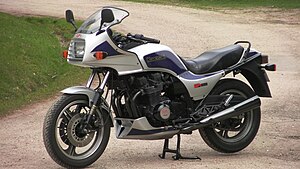Kawasaki GPZ1100
 |
|
| Manufacturer | Kawasaki Heavy Industries Motorcycle & Engine |
|---|---|
| Parent company | Kawasaki Heavy Industries |
| Production | 1981-1985 |
| Engine | 1,089 cc (66.5 cu in) 4 cylinders in line, 4-stroke air/oil cooling |
| Bore / stroke | 72.5 mm × 66 mm (2.85 in × 2.60 in) |
| Compression ratio | 8.9:1 |
| Power | 120 hp (89 kW) |
| Torque | 73 lb·ft (99 N·m) |
| Seat height | 805 mm (31.69 in) |
| Weight | 562 lb (255 kg) (wet) |
The Kawasaki GPZ1100 is a motorcycle that was manufactured by Kawasaki from 1981 to 1985. All five models featured fuel injection and 1,089 cc engines. All were short lived and were an attempt to fill a market segment that was rapidly changing.
The 1981 GPz1100 was the first 1,100 cc motorcycle released by Kawasaki. It was officially marketed as the GPz1100 B1. Its frame design was a typical cradle design and the engine was based on the earlier Mk2 engines of the z1000H and z1000J, but the engine capacity was increased to 1,089 cc.
Rather than featuring carburetors, the B1 was fitted with electronic fuel injection (EFI)as used on the earlier 1980 Z1000G/H models. The key cosmetic change was the paint scheme and the return to a painted black engine similar to the original Z1 released in 1973.
Suspension and braking was similar to earlier models; the front forks featured 38 mm tubes, the frame design, based on the z1000H and J models was made from larger diameter steel in the section between the steering head to rear of the tank. To reduce weight, the tube walls were thinner. It weighed 255 kg (562 lb) with a full tank of fuel, and the power output was claimed to be 108 bhp (81 kW).
The B1 was followed the following year by the GPz1100 B2; the B2 featured a cockpit fairing, the use of LCD warning lights and improved engine coating using a black chrome finish instead of the previous black paint. Kawasaki was serious about having the best Superbike, and the B2 was changed in several significant ways over its predecessor. The engine output was increased by increasing the valve lift from 8.3 mm to 8.7 mm, and valve duration was increased from 280 degrees to 288 degrees to boost upper-end horsepower. The early BOSCH-type analog fuel injection was scrapped, and a new digital fuel injection (DFI) was used in its place. The new system did not use the 'flapper' to measure airflow, but a digital microprocessor, a series of sensors, and a throttle position sensor to meter the fuel much more accurately, eliminate throttle lag, and decrease emissions.
The suspension calibration was all-new for 1982, to make the big GPz an even better handler both on the track and on the street. The fork had slightly stiffer springs, and compression and rebound damping were increased approximately 10%. In the rear, the Kayaba shocks used the same springs, but with greater pre-load, and the compression damping was effectively doubled. And each of the rebound adjustments offered 30% more damping than its '81 counterpart. Wider, Dunlop K300 tires replaced the Bridgestone tires used on the B1 to improve handling and steering response. The B2 was also offered in a gold colour finish called "Sonic Gold".
...
Wikipedia
